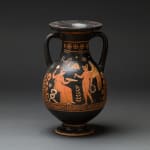Apulian Red-Figure Pelike, 400 BCE - 300 BCE
Terracotta
height 35.1 cm
height 13 3/4 in
height 13 3/4 in
AM.0020
Further images
A Pelike is a type of amphora with two handles, where the broadest part of its body is below the mid-point of its height. The shape of the vessel was...
A Pelike is a type of amphora with two handles, where the broadest part of its body is below the mid-point of its height. The shape of the vessel was originally designed as a storage receptacle for liquids, particularly oil and wine, but it is likely that elaborately decorated examples such as this one served a funerary purpose. Indeed, the excellent level of preservation suggests this also. The obverse depicts a seated draped female, with her hair pulled high beneath a sakkos. Her left foot is raised slightly in front of the right and she holds a mirror in her raised right hand. This is a common motif on funerary vessels. In her left hand she holds a phiale in a movement of gesture towards a winged representation of Eros. The god wears a similar sakkos, clutching a fan in his right and a tambourine in his left. A fillet is depicted in the field above the female and a rosette hovers above the god of love. As is typical for South Italian vases, details are added with white paint to accent the decoration.
The figures are flanked on either side by a palmette design. Around the rim of the neck is a band of rosette and dotted ovolo motifs, whilst the base is encircled by the meander design. The reverse depicts two draped males facing one another with a possible shield between them. The figure on the left holds a staff in his right hand, while the figure on the right has both his arms wrapped in the drapery. It could be that this is the deceased figure, for bodies would be completely wrapped in their cloaks prior to their cremation or interment. It could be that the figure on the left is a depiction of him in his life, and now he faces his death – with the addition of the shield, it could be that he died in war.
The damage to this vessel is minimal. There is only one slight crack on the rim. The quality of the obverse painting is wonderful and highly detailed. It was usual for two artists to work on a vessel, one senior and one junior. The different hands can be seen when comparing both sides of this vessel making it very interesting. It was also crafted by a master potter, for the shape is smooth and regular and the foot is completely flat. It is a striking piece both in terms of its decoration and shape, but especially more so due to its near perfect preservation.
The figures are flanked on either side by a palmette design. Around the rim of the neck is a band of rosette and dotted ovolo motifs, whilst the base is encircled by the meander design. The reverse depicts two draped males facing one another with a possible shield between them. The figure on the left holds a staff in his right hand, while the figure on the right has both his arms wrapped in the drapery. It could be that this is the deceased figure, for bodies would be completely wrapped in their cloaks prior to their cremation or interment. It could be that the figure on the left is a depiction of him in his life, and now he faces his death – with the addition of the shield, it could be that he died in war.
The damage to this vessel is minimal. There is only one slight crack on the rim. The quality of the obverse painting is wonderful and highly detailed. It was usual for two artists to work on a vessel, one senior and one junior. The different hands can be seen when comparing both sides of this vessel making it very interesting. It was also crafted by a master potter, for the shape is smooth and regular and the foot is completely flat. It is a striking piece both in terms of its decoration and shape, but especially more so due to its near perfect preservation.





